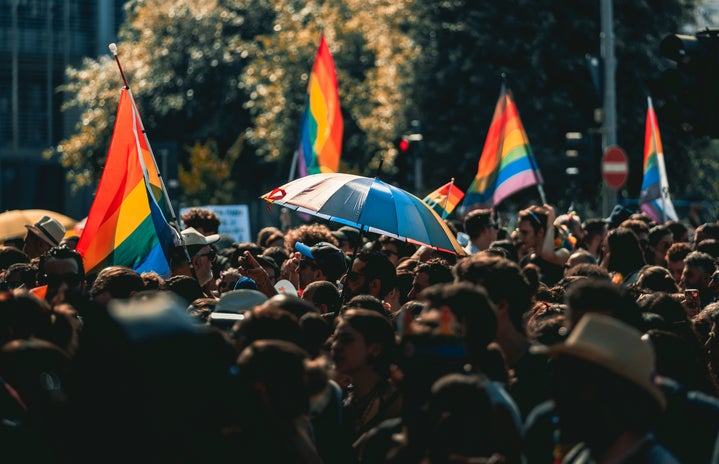It’s been over a year and a half since the COVID-19 pandemic hit Canada in February of 2020, and with this has come many comments on how people couldn’t believe how poorly the governments around the world have handled it. However, to the thousands of LGBTQ+ people living around the world, this was no surprise, because many of them have seen the poor management of a worldwide health crisis before.
In the 1980s and 90s a mysterious disease hit New York, and then the world. No one had ever seen anything like it and doctors were baffled, calling the disease a “gay cancer,” as it only seemed to affect gay men. Originally called GRID (gay-related immune deficiency) by medical professionals in America, the CDC (Center for Disease Control) renamed it AIDS (Acquired Immunodefiency Syndrome) in 1982. By then, the name “gay plague” had caught on, causing the public to turn on the already oppressed LGBTQ+ community.
So what is AIDS? AIDS stands for acquired immunodeficiency syndrome and is caused by HIV (human immunodeficiency virus). HIV is a virus that attacks the immune system (specifically a white blood cell called CD4), weakening it until even a common cold can kill you, though the most common cause of death from AIDS is pneumonia or cancer. HIV is spread through fluids—most often transmitted through unprotected sex—but it can also be passed through blood and the sharing of needles. There are medications that can stop HIV from becoming AIDS, but once you contract HIV there is no cure. Currently it affects two groups of people the most: the gay community and citizens of countries where there is limited access to HIV healthcare.
The world’s governments’ treatment of the AIDS epidemic has had lasting effects to this day. The most obvious example is restrictions on gay men to donate blood. In 1985 the FDA banned gay men from donating blood, and this ban was only lifted in America in 2015, but even then, gay men were required to remain celibate for one year before giving blood. Blood banks are often short on blood and this law denies a large group of people from donating a life-saving force. Blood bans also stigmatized an entire group of people, just as they were gaining ground in rights. In fact, homosexuality had just been decriminalized in 1969 in Canada, in 18 U.S. states in the 1970s, and in 1967 in England. However, hate crimes against LGBTQ+ people were rising at the same time, with a 41% increase in hate crimes related to sexual orientation from 1988 to 1989 alone. Not only were gay people disporportionaltely dying from AIDS, but they were also being killed on the streets.
Governments’ handling of AIDS was appalling. Everywhere, hospitals were refusing to treat AIDS patients and funeral homes weren’t even accepting their bodies. Nurses and doctors refused to treat AIDS patients, and with the ban on gay men’s blood donations, the blood stock just couldn’t handle the influx of patients. This is when the lesbian community stood up. They became nurses, started food banks, and donated blood, caring for these men when doctors and nurses wouldn’t go near them. They let AIDS patients know they were loved when the world abandoned them. (Fun fact! The “L” comes first in the LGBTQ+ acronym because of the efforts and solidarity lesbians showed during the AIDS epidemic). The community was forced to help each other because they were being ignored by the government.
For example, Ronald Reagan, who was the US President at the time, did not even acknowledge the AIDS epidemic until 1987, 10 years after the first case was found and after 20,000 Americans had already died from AIDS. The first Canadian Research Committee for AIDS was founded in 1986, after about 2000 people had already died in Canada, as well as tens of thousands of others worldwide. In1987 the first drug to treat HIV/AIDS—called AZT (Zidovudine)—was introduced, even though it was previously a cancer treatment that had been discontinued for being too toxic and uncontrollable. The FDA forced the panel of AIDS doctors they had gathered to approve this drug even though no sufficient research had been conducted, and it had previously harmed people more than it helped them due to its toxicity. Though some AIDS patients were recovering after receiving the drug, after about a year it was shown that the recovery from the illness was short-lived but the toxicity of the drug remained in their systems, and those who received the drug still died anyway. The drug company who made AZT—Burroughs Wellcome—profited immensely off a drug that did nothing to slow the death rate of AIDS, selling it for a price so high that it was considered the most expensive drug at the time. AIDS patients were paying huge amounts of money for a drug that did not prolong their lives nor slow the spread of AIDS. By the end of 1999 around 500,000 AIDS victims had died in the US alone.
It’s often heard nowadays that there are more LGBTQ+ people now than ever before, and that it’s “popular” to be gay now. While this is not even close to being true (only 4.1% of adults in the US identify as LGBTQ), younger generations, Millennials, and Generation Z, seem to be coming out at rates unseen in older generations. Only 2.4% of baby boomers and 3.5% of Generation X identify as LGBTQ, so why are these numbers so much lower? It’s because these are the generations that lived and were affected by the AIDS epidemic. Among other reasons, the lack of older LGBTQ+ people is directly linked to the AIDS epidemic. We lost so many people to a disease because the government didn’t take it seriously soon enough, calling it a “gay plague” and a death sentence, allowing all these people to die without a second thought.
Most people do not realize the profound effect that AIDS had on our community because it isn’t talked about. It’s pushed to the side in history, just like it was pushed aside at the height of its destructiveness. AIDS is still an ongoing issue; as of 2019 there are 38 million people living with HIV, and the number of AIDS-related deaths just keeps going up. It’s very prevalent in South Africa and other African countries, as well as in Central Asia and Eastern Europe—places with limited access to HIV treatment. COVID-19-related restrictions are also slowing the distribution of HIV treatments, which may contribute to an additional 500,000 AIDS deaths. AIDS is also a pandemic and we need to be educated about it.
World AIDS Day is on December 1st yearly, offering a day where people are focused on educating each other about AIDS. If you’d like to learn more about AIDS, check out my references below. To do your part, you can donate to AIDS charities. Here is a link to some Canadian AIDS charities. The Channel 4 show “It’s A Sin” offers a realistic look at the AIDS epidemic in the UK, and there are many more documentaries that offer information on this crisis. AIDS is a serious health issue that has been unfairly stigmatized due to the people it affects. Increased awareness will allow for others to protect themselves, as well as for more funding to provide HIV medications where people need it most.
https://www.latimes.com/archives/la-xpm-1990-02-23-me-1220-story.html
https://www.spin.com/featured/aids-and-the-azt-scandal-spin-1989-feature-sins-of-omission/
https://www.healthline.com/health/hiv-aids/medications-list#instis
https://www.cdc.gov/hiv/basics/whatishiv.html
https://inews.co.uk/opinion/comment/the-lesbian-blood-sisters-who-helped-save-gay-mens-lives-235100
https://www.nbcnews.com/feature/nbc-out/record-4-5-percent-u-s-adults-identify-lgbt-gallup-n877486
https://www.verywellhealth.com/how-many-people-die-from-aids-each-year-49053


